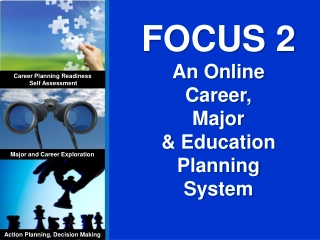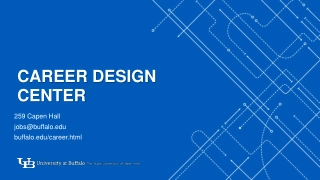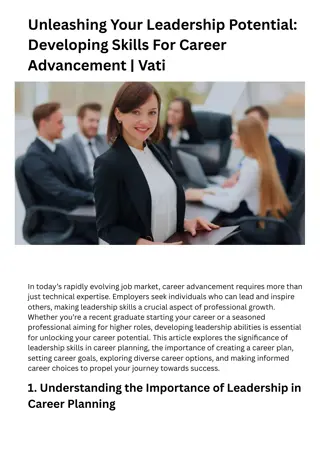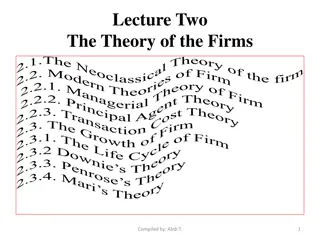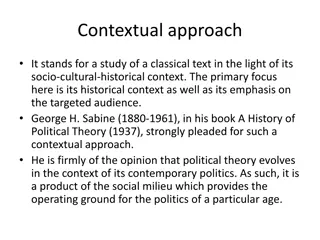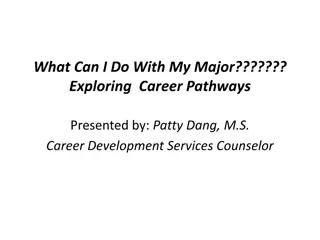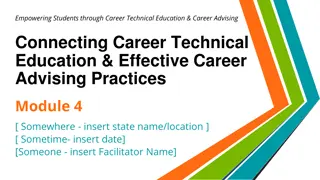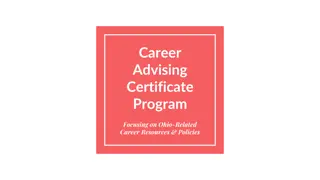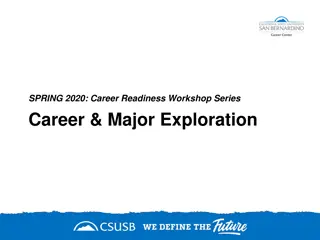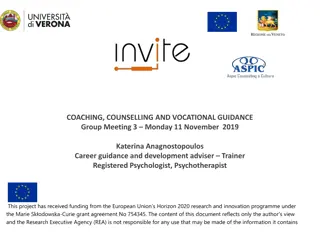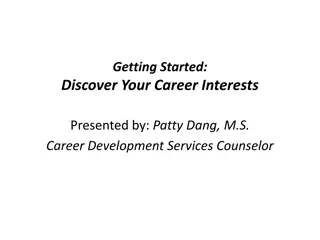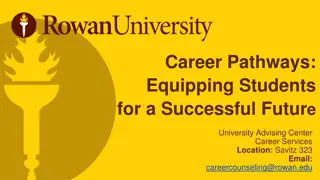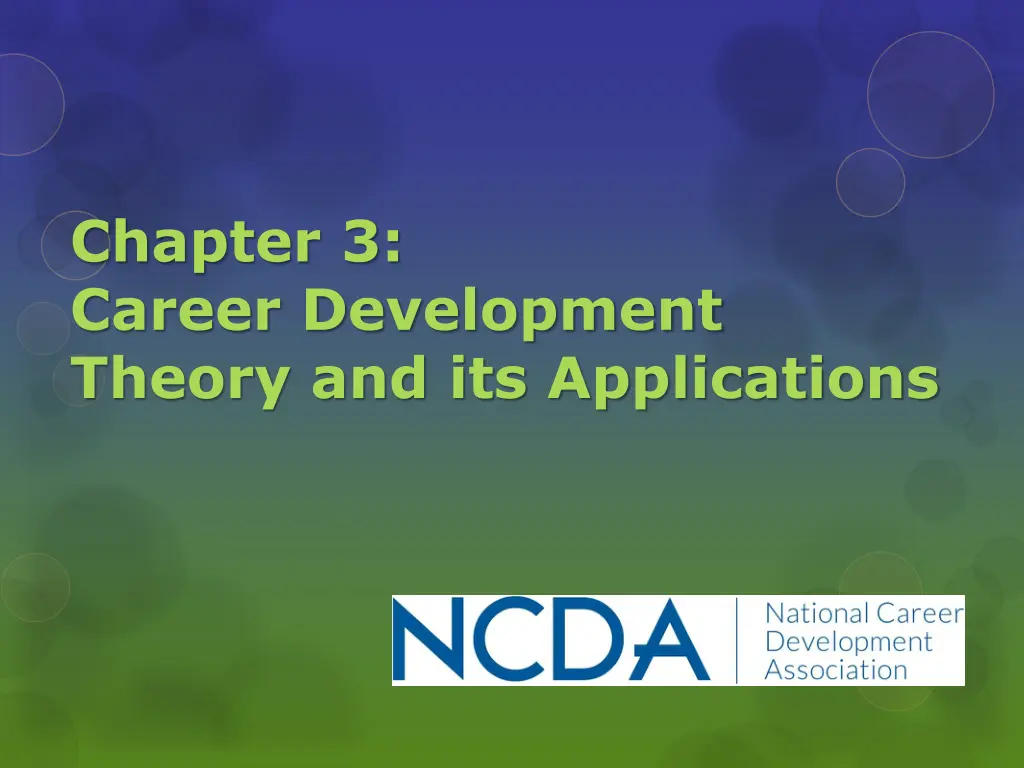
Career Development Theory: Key Concepts and Applications
Explore the essence of career development theory and its practical applications in guiding individuals through occupational choices and transitions. Learn about essential terms, theories, and the career planning process to enhance understanding and support clients effectively.
Download Presentation

Please find below an Image/Link to download the presentation.
The content on the website is provided AS IS for your information and personal use only. It may not be sold, licensed, or shared on other websites without obtaining consent from the author. If you encounter any issues during the download, it is possible that the publisher has removed the file from their server.
You are allowed to download the files provided on this website for personal or commercial use, subject to the condition that they are used lawfully. All files are the property of their respective owners.
The content on the website is provided AS IS for your information and personal use only. It may not be sold, licensed, or shared on other websites without obtaining consent from the author.
E N D
Presentation Transcript
Chapter 3: Career Development Theory and its Applications
Learning Objectives 1. Review key career development theories, models, and techniques and apply them to the client populations you serve. 2. Define the following terms: occupation, job, career, career development, career counseling, career assistance, career guidance, and career planning process. 3. Describe the steps in the career development process. 4. State the reasons why understanding career choice and development theory is important. 5. State the limitations of career choice and development theories. 6. Explain the importance of Maslow s Hierarchy of Needs to the work of a career services provider. 7. Describe in detail the assumptions that underlie each of the four theory types: trait-and-factor, learning, developmental, and transition. 8. Review the details of additional career development theories. 9. Describe specific ways each of these theories can be applied to client cases.
Definitions Occupation a defined set of work tasks commonly performed for the purpose of making a particular product or performing a specific service Job performance of an occupation in a specific place for a specific employer Career the combination of activities performed at any given life stage in all roles of life, including the role of worker
Definitions Career Coach: a person who guides another in planning and managing their career and developing an array of options related to career goals. Career development sequence of career-related choices and transitions made over the life span Career counseling the process by which a professional counselor provides assistance to clients so that they can make informed career choices and transitions Career assistance the process by which a Career Development Facilitator provides defined kinds of support to clients, including helping to find career information or conduct a job search Career guidance a planned, sequential program of services provided to individuals of groups for the purpose of assisting them in making informed career choices and transitions Career planning process the steps an individual goes through in order to plan a career
The Career Planning Process
Role of the Career Services Provider To help clients understand the process To offer activities and resources that may help to identify and clarify alternatives To assist clients to use the information gained in ways that help with making a choice To refer clients for assistance from others if their needs exceed the scope of your work and training
Importance of Theories Attempt to explain both the factors involved in the career planning process and the way they work together. Attempt to predict future events, such as satisfaction/dissatisfaction in a specific kind of work Provide guidelines, tools, and techniques for practice.
Limitations of Theories Each theorist looks at career choice and development from a different perspective and focuses heavily on specific selected aspects. Samples used for research may not be representative of total population Theories may not apply as well to minority groups as they do to the groups on which they were originally formed and tested They are culture bound Many different types of career development theories
Maslows Hierarchy of Needs
Trait-and-Factor Theory Individuals have unique characteristics related to interests, abilities, needs, values, and personality traits. Occupations and jobs have unique characteristics related to work tasks, skills, demands, and rewards. The unique characteristics of both individuals and occupations/jobs can be measured. Workers and employers are most satisfied when there is a good match or fit between the characteristics
Basic Concepts of Vocational Choice Theory (Holland) Each individual can be described as a combination of three or more types Environments can be described as a combination of three or more types Individuals seek environments which have the same or similar type as theirs Finding such a match predicts satisfaction, longevity, and contribution
Hollands Six Types Realistic tends to work with hands, tools, equipment, and sees tangible results; often has mechanical abilities and is a problem solver Investigative often values abstract thinking, ideas; prefers to work alone; introspective, analytical, and curious Artistic independent, nonconforming, intuitive, and values the creative expression of ideas and emotions Social prefers working with others to inform, counsel, train, develop, cure, and/or enlighten Enterprising works face-to-face with people to sell, lead, manage; high value on influencing others Conventional prefer to work with explicit, ordered, and systematic manipulation of data and information
Three Important Concepts Consistency the relationship of the first two letters of a Holland code as indicated by the hexagon Differentiation the numerical difference between the lowest and highest of the six scores of a profile Congruence the degree of fit between a person s personality type and a work environment
Personal Codes An individual s Holland code is usually expressed as a two- or three-letter code Two or more letters may be tied, however, in any one of the 3 positions An individual s code can be determined by Completing an informal assessment Administering an interest inventory Examining past jobs
Practical Applications of Holland s Theory To learn about the interests and preferences of individuals To assist individuals to find jobs where they can express their interests To assist individuals to choose majors, schools, and leisure activities To understand why people are satisfied or dissatisfied in their work To organize high school curriculum or college majors To organize career information, job shadowing, and career days To provide the structure for career guidance services
Learning Theory There are three important determinants of career choice and development: heredity, environment, and learning experiences Career services providers can have impact on the third, but it is useful to understand the impact of heredity and environment Positive reinforcement occurs when specific behaviors are rewarded. Negative reinforcement occurs when some aversive stimulus is terminated.
Types of Learning Instrumental positive outcomes (praise, financial return, positive emotions) follow a given behavior Associative people observe outcomes that are experienced by others and take these persons as role models.
Happenstance Theory Career service providers should encourage clients to explore and take advantage of the unexpected While maintaining an attitude of planning, one is also open to exploration and unexpected opportunities Chance events can have a positive or negative influence on us. Things happen, and sometimes turn into new opportunities. The four key attitudes to foster regarding unexpected events are: Curiosity Persistence Flexibility Optimism
Practical Application of Krumboltzs Social Learning Theory The following concepts are typically used when applying this theory: instrumental learning associative learning reinforcement (both positive and negative) modeling observing practicing happenstance
Developmental Theory Focuses on how careers unfold over the life span. Factors that contribute to growth and maturity are complex and multifaceted. Life can be divided into a specific number of age- related stages. Each stage is characterized by specific developmental tasks that should be accomplished during that stage. Though there is a variation in timing, most people experience these stages and tasks at some point in their lives
Career Development Theory of Donald E. Super Leading developmental theorist is Donald Super. There are three aspects to his theory: self-concept life span life space The nature of the career pattern is determined by: individual s parental socioeconomic level mental ability education skills personality characteristics career maturity and by the opportunities to which an individual is exposed
Self-concept Formation of a self-concept begins as soon as a baby realizes that he or she is a separate being Growth and richness of the self-concept continues throughout our entire lives. Its development is influenced by: the culture in which we live the family in which we are born the experiences that we have and the events that befall us Self-concept is a picture of who we are and what we are like. It is a blend of: how we see ourselves how we would like to be seen and how we think others view us It includes both subjective and objective information.
Supers Stages and Approximate Ages STAGE AGE Growth 0 15 Exploration 15 25 Establishment 25 45 Maintenance 45 65 Disengagement 65 ?
Supers Five Developmental Tasks Crystallization Specification Implementation Stabilization Consolidation
Life Space - The Breadth of One s Career According to Super LIFE SPACE is a term used to describe all of the time and energy that we have. CAREER is the combination of life roles being played at any given point across the life span as represented on the Career Rainbow Distance from left to right on the rainbow represents time, with birth at the far left and death at the far right. Each band represents one of the major life roles.
Definition of Supers Eight Roles Son/Daughter the time and energy spent in relating to parents Student/Learner the time and energy spent in learning and acquiring skills Worker the time and energy spent in paid employment Spouse/Partner the time and energy spent in cultivating and maintaining a relationship with a partner Homemaker the time and energy spent by either men or women in preparing food, cleaning, and all other activities related to maintaining the place where we live Parent the time and energy spent in rearing children Leisurite - the time and energy spent in activities for relaxation, including reading, sports activities, going out to dinner, etc. Citizen the time and energy spent in volunteer activities in the community
Nature of Life Roles Roles change in bandwidth and intensity over the life span Roles inevitably interact with each other and affect each other Interests, skills, and values can be assigned to a variety of life roles Satisfaction and stress that one experiences in life are often directly related to the number and combination of roles being played
Importance of Values List of values that people attempt to attain through work Lifestyle Ability utilization Physical activity Achievement Prestige Aesthetics Risk Altruism Social interaction Autonomy Variety Creativity Surroundings Economic Rewards
The Archway of Career Determinants
Practical Applications of Super s Developmental Theory Importance of helping the client/student explore cultural influences and in particular, those influences that have an impact on one s career development and perceptions of the work role Using the Career Rainbow to assist young people in planning for future life roles and to assist adults in balancing their life roles Assisting individuals in assessing their personal values Assisting people in understanding their vocational self-concept
Transition Theory Life is characterized by change and an ongoing series of transitions. Transitions can be viewed as events (or nonevents) that cause change in an individual s roles, relationships, or routines. Transitions have varying degrees of impact on different individuals, depending upon a number of factors. Success in life may be more closely related to the ability of individuals to cope effectively with change and transition than to life s events in general.
Schlossbergs Definitions An event is something that happens, such as getting married, having a child, receiving a promotion, or getting into your first-choice school A nonevent is something that you expected and wanted to happen, but it did not like not getting married, not having a child, not receiving a promotion as expected, not getting accepted into school
Schlossbergs 4-S Transition Theory Coping skills Competencies Outlook on life Timing Impact Control SITUATION SELF SUPPORTS STRATEGIES Additional support? Alternatives? Steps to take? People Agencies Financial capability
The Situation On a 1 10 scale, how bad is it? What is its timing (worst or best possible time)? How long is there to absorb its impact? Is there anything positive about it? How much control can I exert over it? Is it temporary or permanent? What else is going on in the person s life at the same time?
The Self Do I see the glass as half empty or half full? Do I believe that I can exert control? Have I had past successful experience with change? Do I know how to cope by using humor, relaxation, exercise, meditation, etc.? What internal resources do I bring?
The Support System Do I have friends and family who are willing to help me through a transition? Am I willing to ask for help or develop a network of supporters? Are there agencies that can help? Are there sufficient material resources to help?
Formulating Strategies Are there inner resources that could be developed? Do I know how to develop an action plan and then follow it? What are the alternatives available? What is the time frame for carrying out these strategies?
Other Theories Integrative Life Planning Theory a way of seeing self and world that takes into account both personal development and the contexts in which we live Cognitive Information Processing Theory looks at three factors: (1) self-understanding; (2) occupational knowledge; (3) how we cognitively process this information Social Cognitive Career Theory based on the critical relationship among self-efficacy beliefs, outcome expectations, and personal goals Strengths-Based Approach changes the focus from problem solving and deficits to a focus on strengths and successes. Value-Based Career Decision Making emphasizes the role that values play in career selection

